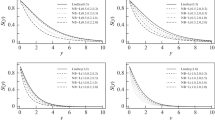Abstract
In this paper, we develop a flexible cure rate survival model by assuming the number of competing causes of the event of interest to follow a compound weighted Poisson distribution. This model is more flexible in terms of dispersion than the promotion time cure model. Moreover, it gives an interesting and realistic interpretation of the biological mechanism of the occurrence of event of interest as it includes a destructive process of the initial risk factors in a competitive scenario. In other words, what is recorded is only from the undamaged portion of the original number of risk factors.
Similar content being viewed by others
References
Balakrishnan N, Kozubowski T (2008) A class of weighted Poisson processes. Stat Probab Lett 78: 2346–2352
Chen MH, Ibrahim JG, Sinha D (1999) A new Bayesian model for survival data with a surviving fraction. J Am Stat Assoc 94: 909–919
Cnaan A (1985) Survival models with two phases and length biased sampling. Commun Stat Theory Methods 14: 861–886
Dunn PK, Smyth GK (1996) Randomized quantile residuals. J Comput Graph Stat 5: 236–244
Feller W (1968) An introduction to probability theory and its applications. 3. Wiley, New York
Fisher RA (1934) The effect of methods of ascertainment upon the estimation of frequencies. Ann Eugen 6: 13–25
Gradshteyn IS, Ryzhik IM (2000) Table of integrals, series, and products, 6th edn. Academic Press, San Diego
Klebanov LB, Rachev ST, Yakovlev AY (1993) A stochastic-model of radiation carcinogenesis: latent time distributions and their properties. Math Biosci 113: 51–75
Kokonendji CC, Mizère D, Balakrishnan N (2008) Connections of the Poisson weight function to overdispersion and underdispersion. J Stat Plan Inference 138: 1287–1296
Li CS, Taylor J, Sy J (2001) Identifiability of cure models. Stat Probab Lett 54: 389–395
R Development Core Team: (2010) R: a language and environment for statistical computing. R Foundation for Statistical Computing, Vienna, Austria
Rao CR (1965) On discrete distributions arising out of methods of ascertainment. Sankhyā Ser A 27: 311–324
Rao CR, Rubin H (1964) On a characterization of the Poisson distribution. Sankhyā Ser A 26: 295–298
Rigby RA, Stasinopoulos DM (2005) Generalized additive models for location, scale and shape (with discussion). Appl Stat 54: 507–554
Rodrigues J, Cancho VG, de Castro M, Louzada-Neto F (2008) On the unification of the long-term survival models. Stat Probab Lett 39: 753–759
Rodrigues J, de Castro M, Cancho VG, Balakrishnan N (2009) COM–Poisson cure rate survival models and an application to a cutaneous melanoma data. J Stat Plan Inference 139: 3605–3611
Scheike T (2009) timereg package, with contributions from T. Martinussen and J. Silver, R package version 1.1-6
Shmueli G, Minka TP, Kadane JB, Borle S, Boatwright P (2005) A useful distribution for fitting discrete data: Revival of the Conway-Maxwell-Poisson distribution. Appl Stat 54: 127–142
Tournoud M, Ecochard R (2007) Application of the promotion time cure model with time-changing exposure to the study of HIV/AIDS and other infectious diseases. Stat Med 26: 1008–1021
Tsodikov AD, Ibrahim JG, Yakovlev AY (2003) Estimating cure rates from survival data: an alternative to two-component mixture models.. J Am Stat Assoc 98: 1063–1078
Yakovlev AY, Tsodikov AD (1996) Stochastic models of tumor latency and their biostatistical applications. World Scientific, Singapore
Yang G, Chen C (1991) A stochastic two-stage carcinogenesis model: a new approach to computing the probability of observing tumor in animal bioassays. Math Biosci 104: 247–258
Zelen M, Feinleib M (1969) On the theory of screening for chronic diseases. Biometrika 56: 601–614
Author information
Authors and Affiliations
Corresponding author
Rights and permissions
About this article
Cite this article
Rodrigues, J., de Castro, M., Balakrishnan, N. et al. Destructive weighted Poisson cure rate models. Lifetime Data Anal 17, 333–346 (2011). https://doi.org/10.1007/s10985-010-9189-2
Received:
Accepted:
Published:
Issue Date:
DOI: https://doi.org/10.1007/s10985-010-9189-2




